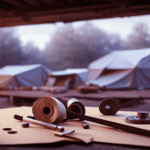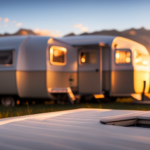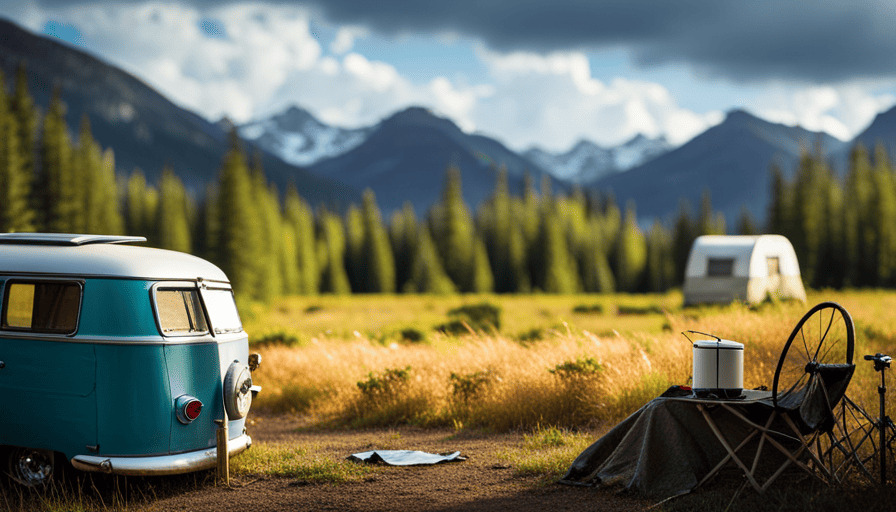Did you know that the roof of a camper is the main defense against environmental elements? In fact, it is estimated that 85% of the damage caused by moisture and weather to campers is a result of weaknesses in the roof. Therefore, understanding the materials used in camper roofs and their role in protecting your investment is crucial.
Camper roofs are constructed using a variety of materials, each with its own unique properties and benefits. From metal and fiberglass to rubber and aluminum, the choice of roof material can greatly impact the durability, insulation, and overall performance of your camper.
In this article, we will explore the different materials commonly used in camper roofs, including composite, PVC, wood, acrylic, and polycarbonate. We will delve into the pros and cons of each material, their resistance to UV rays and leaks, and their ability to withstand extreme weather conditions.
By the end of this article, you will have a comprehensive understanding of the various materials used in camper roofs, enabling you to make an informed decision when it comes to protecting your camper from the elements.
So, let’s dive in and discover what camper roofs are made of!
Key Takeaways
- Camper roofs are made of various materials such as metal, fiberglass, rubber, aluminum, composite, PVC, wood, acrylic, and polycarbonate.
- Metal roofs are lightweight and durable but prone to denting, scratching, and getting hot in direct sunlight.
- Fiberglass roofs are lightweight, easy to repair, and resistant to weather and UV damage, but more expensive than metal roofs.
- Rubber roofs are durable, weather-resistant, prevent leaks, and easy to install.
Metal
So you’re probably wondering, what’s the deal with camper roofs? Well, let me tell you, they’re usually made of metal!
Metal roofs are a popular choice for campers due to their durability and strength. They are typically constructed using aluminum or steel materials, which provide excellent protection against the elements.
Metal roofs offer several advantages. Firstly, they’re lightweight, which helps to keep the overall weight of the camper down. This is especially important for towing and fuel efficiency. Secondly, metal roofs have a long lifespan and can withstand harsh weather conditions such as heavy rain, snow, and strong winds. They’re also resistant to fire, making them a safer option for campers.
However, metal roofs also have a few drawbacks. They can be prone to denting and scratching, especially if they come into contact with tree branches or other objects. Additionally, metal roofs can be noisy during rainstorms, as the raindrops tend to create a loud pitter-patter sound. Lastly, metal roofs can get very hot in direct sunlight, which can make the interior of the camper uncomfortable.
Now, let’s move on to the next section about fiberglass roofs.
Fiberglass
Fiberglass is a popular material for camper roofs due to its lightweight and easy-to-repair nature. Its composition of glass fibers embedded in a resin matrix makes it strong yet lightweight, allowing for better fuel efficiency and handling. Additionally, fiberglass is highly resistant to weather and UV damage, ensuring a long lifespan for the camper roof. However, it’s important to note that fiberglass roofs can be more expensive than roofs made of other materials, such as metal.
Lightweight and easy to repair
When it comes to camper roofs, you’ll love how lightweight and easy they are to repair, thanks to their clever construction. The lightweight construction of camper roofs is achieved by using materials such as fiberglass or aluminum. These materials not only make the roof easy to handle but also contribute to fuel efficiency when towing the camper.
Additionally, lightweight roofs offer cost-effective options as they require less structural support, reducing the overall weight and cost of the camper. Repairing a camper roof is a breeze due to its simple design. Common repairs include patching small holes or cracks with a fiberglass repair kit or replacing damaged sections with new materials. Moreover, the lightweight nature of the roof makes it easier to lift and work on during repairs.
Transitioning to the next section, camper roofs are also designed to be resistant to weather and UV damage.
Resistant to weather and UV damage
You’ll be impressed by how camper roofs withstand harsh weather conditions and protect against harmful UV damage. The materials used in camper roofs are chosen for their exceptional weather resistance and durability.
One commonly used material is fiberglass, which is known for its strength and ability to withstand extreme temperatures. Fiberglass roofs are resistant to cracking, peeling, and fading, making them ideal for withstanding the elements.
Another popular option is aluminum, which is lightweight yet incredibly durable. Aluminum roofs are resistant to corrosion and can withstand heavy rain, snow, and wind.
These materials ensure that your camper roof will remain intact and continue to provide protection for years to come. However, it’s important to note that the superior weather resistance and durability of these materials can come at a higher cost compared to other options. Nonetheless, the investment is worth it for the long-lasting performance and peace of mind.
Can be more expensive than other materials
If you want a roof that can withstand harsh weather conditions and protect against UV damage, be prepared to invest a bit more as these materials can be pricier compared to others, but the added expense is worth it for the peace of mind knowing your roof will last for years to come.
When considering camper roofs, it’s important to weigh the cost effectiveness of different materials. While there are cheaper options available, such as fiberglass or aluminum, they may not offer the same level of durability as more expensive materials like rubber.
Rubber roofs are known for their exceptional durability and resistance to weather and UV damage. They’ve proven to be a cost-effective choice in the long run, as they require less maintenance and are less likely to need replacement compared to other materials.
Transitioning into the subsequent section about ‘rubber’, it’s worth exploring its unique properties and benefits.
Rubber
Rubber is the go-to material for camper roofs because it provides a durable and weather-resistant solution. Rubber roofing offers numerous benefits that make it an ideal choice for campers.
Firstly, rubber roofs are excellent at preventing leaks, as they have a seamless design that eliminates the risk of water infiltration. This is especially important for campers, as they are constantly exposed to the elements.
Additionally, rubber roofs are highly resistant to UV rays, which helps prolong their lifespan and prevents them from deteriorating under the sun’s harsh rays.
The installation process for rubber roofs is relatively straightforward. It typically involves cleaning and preparing the camper roof, applying an adhesive or sealant, and then rolling out the rubber roofing material. The rubber is then secured in place using fasteners or adhesive, ensuring a tight and secure fit. This installation process is efficient and can be completed by professionals or even experienced DIY enthusiasts.
While rubber is a popular choice for camper roofs, another common material is aluminum. Aluminum roofs offer their own set of benefits, including lightweight construction and excellent heat resistance. Transitioning into the subsequent section about aluminum, it is important to consider the different qualities and advantages that this material brings to camper roofs.
Aluminum
After discussing the previous subtopic about rubber camper roofs, let’s now dive into the current subtopic: aluminum.
When it comes to camper roofs, aluminum is a popular material choice due to its durability and lightweight nature. Compared to fiberglass, aluminum offers several advantages.
Firstly, aluminum roofs are known for their strength and longevity. They’re highly resistant to impact, making them ideal for protecting your camper from falling branches or hail. Additionally, aluminum roofs require minimal maintenance, as they’re less prone to cracking or chipping compared to fiberglass.
Another advantage of aluminum roofs is their weight. Being lighter than fiberglass, aluminum roofs contribute to a lower overall vehicle weight, which can enhance fuel efficiency and ease of towing.
However, aluminum roofs also have some drawbacks. They can be prone to denting if hit by heavy objects, and they may require more frequent resealing to prevent leaks. Additionally, aluminum roofs can be more expensive than fiberglass options.
Transitioning into the subsequent section about composite materials, it’s worth exploring another alternative to both aluminum and fiberglass.
Composite
Composite roofs, on the other hand, offer a unique combination of strength and flexibility that sets them apart from both aluminum and fiberglass options. Made from a blend of different materials, such as fiberglass, resin, and foam, composite roofs provide excellent durability and insulation properties. The use of fiberglass in the composite structure enhances its strength, making it resistant to impacts, cracks, and deformation. Additionally, the resin component adds flexibility to the roof, allowing it to withstand various weather conditions without losing its shape.
One of the advantages of composite roofs is their lightweight nature, which contributes to improved fuel efficiency and overall vehicle performance. Furthermore, the insulation properties of composite materials help regulate the temperature inside the camper, keeping it cool in hot weather and warm in cold temperatures. Composite roofs also have a smooth surface, which makes them easy to clean and maintain.
However, there are some disadvantages to consider with composite roofs. Due to their complex construction, they can be more expensive to manufacture and repair compared to other roof options. Additionally, composite roofs may require periodic inspection to ensure that the different materials are properly bonded and that no delamination occurs.
Transitioning to the next section, canvas roofs offer a different approach to camper roofing, utilizing a lightweight and flexible material that provides unique benefits.
Canvas
After discussing composite camper roofs, let’s move on to another popular material used in camper roofs: canvas.
Canvas is a lightweight and flexible material that offers several advantages for camper roofs.
Firstly, canvas roofs provide excellent durability. They are designed to withstand harsh weather conditions and can resist tearing and punctures. This makes them a reliable choice for outdoor enthusiasts who often venture into rugged terrains.
Secondly, canvas roofs offer good insulation. The material has natural thermal properties that help regulate the temperature inside the camper. It can keep the interior cool during hot summer days and provide warmth during colder seasons.
Additionally, canvas roofs are also known for their breathability. They allow air circulation, preventing condensation and mold growth inside the camper. This feature is particularly beneficial for those who enjoy camping in humid climates.
Lastly, canvas roofs are relatively easy to maintain. They can be cleaned with mild soap and water, and any repairs or patching can be done with simple tools.
Moving forward, let’s delve into the next subtopic: PVC.
PVC
To fully appreciate the benefits of PVC, imagine yourself on a camping trip with a lightweight and flexible material that offers durability, insulation, breathability, and easy maintenance. PVC, or polyvinyl chloride, is a popular material used in camper roofs due to its exceptional durability. It is resistant to various environmental factors such as UV rays, extreme temperatures, and moisture, making it highly suitable for outdoor use.
PVC roofs are known for their long lifespan and ability to withstand harsh weather conditions. In addition to its durability, PVC also provides excellent insulation properties. The material has a low thermal conductivity, meaning it helps to regulate the temperature inside the camper. This insulation feature helps to keep the interior cool in hot weather and warm in colder temperatures, making it comfortable for camping throughout the year.
Furthermore, PVC roofs are easy to maintain. They require minimal cleaning and can be easily wiped down with a cloth or washed with water and mild soap. The material is also resistant to mold and mildew growth, ensuring a hygienic camping experience.
Transitioning to the next section about ‘wood’, it is important to consider alternative roofing materials that provide a different set of benefits.
Wood
Wood is a natural and aesthetically pleasing material commonly used in the construction of camper roofs. However, it requires regular maintenance to prevent rot and water damage.
Additionally, due to its weight, it may require additional support to ensure structural integrity.
Natural and aesthetically pleasing
Imagine you’re sitting in your cozy camper, gazing up at the marvelously majestic roof that’s not some boring old wood, but rather a breathtaking masterpiece crafted from the finest materials Mother Nature has to offer.
Camper roofs made from natural materials are not only aesthetically pleasing but also eco-friendly options. These roofs can be constructed with a variety of materials such as thatch, bamboo, or even living green roofs. Thatch roofs provide a rustic and charming look, while bamboo roofs offer strength and durability. Living green roofs not only enhance the visual appeal but also provide insulation and reduce environmental impact.
However, it’s important to note that these natural roofs require regular maintenance to prevent rot and water damage.
Transitioning into the subsequent section, proper care and upkeep are necessary to ensure the longevity of these beautiful roofs.
Requires regular maintenance to prevent rot and water damage
Regular maintenance is essential to prevent rot and water damage in these stunning, eco-friendly roofs. To ensure the longevity of camper roofs, here are four important maintenance tasks that should be performed regularly:
-
Inspect for cracks and leaks: Regularly check the entire roof surface for any signs of cracks or leaks. Repair them promptly to prevent water from seeping in and causing damage.
-
Clean the roof: Remove debris, leaves, and branches from the roof to prevent clogging of drainage systems and the formation of stagnant water.
-
Apply protective coatings: Regularly apply protective coatings to the roof surface to enhance its resistance against moisture and UV rays.
-
Check and maintain seals: Inspect and maintain the seals around vents, skylights, and other roof protrusions to prevent water penetration.
By diligently carrying out these maintenance tasks, camper owners can ensure their roofs remain sturdy and free from rot and water damage.
Additionally, it’s important to note that these roofs can be heavy and may require additional support, as discussed in the next section.
Can be heavy and may require additional support
To ensure the structural integrity of your camper roof, it’s crucial to consider that these roofs can be quite weighty and might necessitate additional support. The materials used for camper roofs, such as fiberglass or aluminum, can add significant weight to the overall structure. This added weight poses potential challenges, as it can strain the camper’s framework and compromise its stability.
To counteract this, additional structural support in the form of reinforcements or braces may be required. These supports help distribute the load evenly and prevent excessive stress on the roof and walls. By providing the necessary reinforcement, you can ensure that your camper roof remains sturdy and durable, even under the additional weight.
This leads us to the next section, where we will discuss the benefits of acrylic roofs.
Acrylic
You’ll love how durable and sleek acrylic camper roofs are, giving your camper a modern and stylish look. Acrylic roofs have become increasingly popular among campers due to their aesthetic appeal, durability, and longevity. Here are five reasons why acrylic roofs are a great choice for your camper:
-
Superior Weather Resistance: Acrylic roofs are highly resistant to UV radiation, extreme temperatures, and moisture. This ensures that your camper remains protected from the elements, even in harsh weather conditions.
-
Lightweight Construction: Acrylic roofs are lightweight compared to other materials, making them easy to install and reducing the overall weight of your camper. This is particularly beneficial if you’re concerned about fuel efficiency and towing capacity.
-
Impact Resistance: Acrylic roofs are known for their excellent impact resistance. They can withstand hail, falling branches, and other high-impact situations, keeping your camper safe and minimizing the risk of damage.
-
Low Maintenance: Acrylic roofs require minimal maintenance to keep them looking their best. They’re resistant to fading, cracking, and discoloration, ensuring that your camper maintains its sleek appearance for years to come.
-
Wide Range of Colors: Acrylic roofs come in a variety of colors, allowing you to choose the one that best matches your camper’s style and personal preferences.
Transitioning to the subsequent section about ‘polycarbonate,’ another popular material for camper roofs, we’ll explore its unique features and advantages.
Polycarbonate
Polycarbonate roofs, with their sturdy and transparent composition, create a captivating and crystal-clear sanctuary for your camper. When it comes to durability, polycarbonate is an excellent choice. It’s incredibly strong and resistant to impact, making it ideal for withstanding harsh weather conditions, such as hailstorms or heavy snowfall.
This durability ensures that your camper roof will last for years to come, providing you with peace of mind during your outdoor adventures.
In addition to its durability, polycarbonate roofs also offer excellent insulation properties. The material has a high thermal resistance, which helps to regulate the temperature inside your camper. This means that during hot summer days, the polycarbonate roof will help keep the interior cool, reducing the need for excessive air conditioning. Similarly, during colder months, the insulation properties of polycarbonate will help retain heat, keeping you warm and cozy inside your camper.
Furthermore, polycarbonate roofs are designed to allow natural light to enter your camper, creating a bright and inviting atmosphere. The transparency of the material allows you to enjoy panoramic views of the surrounding scenery, bringing you closer to nature even when you’re indoors.
Overall, polycarbonate roofs offer a combination of durability and insulation that make them an excellent choice for camper roofs. With their ability to withstand impact and regulate temperature, they provide a reliable and comfortable environment for your camping adventures.
Frequently Asked Questions
Are camper roofs made of metal suitable for all types of weather conditions?
Camper roofs can be made of various materials, including metal. Metal roofs offer several advantages, such as durability, longevity, and resistance to fire. They’re also lightweight and require less maintenance compared to other materials. However, metal roofs can be prone to denting and can be noisy during rain or hailstorms. Additionally, they can conduct heat, making the interior hotter in warm weather.
Therefore, while metal roofs are suitable for many weather conditions, they may have some drawbacks to consider.
Can fiberglass camper roofs be easily repaired if they get damaged?
Fiberglass camper roofs, a popular choice among outdoor enthusiasts, are known for their durability and lightweight composition. When it comes to repairing damaged roofs, fiberglass offers an advantage.
A study conducted by RV industry experts found that fiberglass camper roofs can be easily repaired in case of damage. With the right materials and techniques, minor cracks or holes in the fiberglass can be effectively fixed, ensuring the longevity and functionality of the roof.
How does a rubber camper roof compare to other materials in terms of durability?
Rubber camper roofs offer excellent durability compared to other materials such as fiberglass and metal. The rubber material used in camper roofs is highly resistant to damage from the elements, such as UV rays and extreme temperatures. This durability ensures a longer lifespan for the roof, reducing the need for frequent repairs or replacements.
Additionally, rubber roofs are less prone to cracking or denting compared to fiberglass or metal roofs, making them a reliable choice for camper owners.
Is aluminum a lightweight option for camper roofs, and does it provide good insulation?
Aluminum roofs for campers are indeed a lightweight option, making them desirable for those seeking to reduce weight and improve fuel efficiency. In terms of insulation, aluminum roofs have moderate insulating properties. However, they may not provide the same level of insulation as other materials such as rubber or fiberglass.
Additionally, aluminum roofs are prone to denting and may require regular maintenance to prevent corrosion. Overall, while lightweight, aluminum camper roofs have some drawbacks compared to other materials.
What are the advantages of using composite material for camper roofs compared to other options?
Composite materials offer significant advantages for camper roofs compared to other options. One interesting statistic is that composite roofs have been found to be up to 50% lighter than traditional materials, making them ideal for improving fuel efficiency and reducing overall weight.
Additionally, composite roofs are highly durable, able to resist impacts, corrosion, and harsh weather conditions. This durability ensures a longer lifespan and lower maintenance costs, making composite roofs a superior choice for camper owners.
Conclusion
In conclusion, camper roofs are made from a variety of materials, each offering unique benefits. From the durable and weather-resistant qualities of metal and aluminum to the lightweight and flexible nature of fiberglass and rubber, there is a material to suit every camper’s needs.
The composite roofs provide a perfect balance of strength and weight, while PVC and wood offer a more traditional aesthetic. For those seeking clarity and transparency, acrylic and polycarbonate roofs are the way to go.
With such an array of materials, camper roofs are built to withstand the elements and ensure a comfortable and secure camping experience.



















